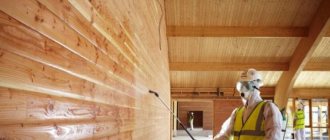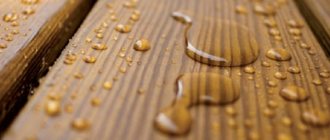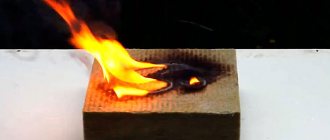As is known, in addition to wood-damaging organisms, wood can be subject to the destructive effects of fire, which is to a certain extent a more intense destructive factor. In this regard, the task fire protection wood no doubt.
To increase the fire resistance of wood, it is widely practiced to treat it with special fire retardant compounds - fire retardants. In this case fire protection of wood materials is achieved by introducing into the wood the required amount of chemicals that, at a certain concentration, can prevent it from burning without a flame source.
Wood fire protection idea
The fire retardant effect of fire retardants is due to a combination of various physical and chemical processes that occur when wood is exposed to fire. It is based both on the melting of fusible substances included in their composition (salts of boric acid, salts of phosphoric or silicic acids), and on the decomposition of substances that emit gases that do not support combustion (ammonia, sulfur dioxide).
In the first case, when wood is heated, a melted film is formed, limiting the access of oxygen to the surface. As a result, part of the heat is spent on melting fire retardants, which leads to an increase in the ignition temperature of wood, and, consequently, to its protection.
In the second case, during the decomposition of salts, non-flammable gases are released, which displace oxygen from the surface of the wood, dilute the flammable gases released from the surface and, thus, prevent combustion.
All this leads to the suppression of wood ignition processes and slowing down the spread of flame over the surface of a wooden structure, which is the purpose of fire protection.
Main types of wood fireproofing agents
The means used for fire protection of wood can be divided into fire-retardant coatings (varnishes, paints, pastes, coatings) and fire-retardant impregnation compositions (impregnations).
Fire retardant coatings, as a rule, worsen the decorative properties of wood and are used primarily to protect non-visible structures. Unlike coatings, impregnating compounds, as a rule, preserve the texture and natural beauty of wood, and therefore find more universal use.
Fire-retardant impregnations, like antiseptics, are divided into water-soluble and organic-soluble.
Organosoluble drugs require the use of hazardous and flammable solvents. For this reason, they are significantly inferior in popularity to water-soluble fire retardant compounds that do not have these disadvantages.
Among organosoluble fire retardant compounds, compounds containing phosphorus and halogen atoms are widely known.
Of the water-soluble fire retardants, the best known are, for example, impregnations that contain phosphoric acid salts (diammonium phosphate, monoammonium phosphate, etc.). Such products have been used as fire retardants for more than 100 years, both in pure form and in mixtures with other salts.
Diammonium phosphate is usually used in a mixture with ammonium sulfate. When such a mixture is heated, non-flammable ammonia gas is released and phosphorus oxides are formed, covering the wood with a protective film.
A mixture of sodium phosphate and ammonium sulfate is also a good fire retardant. A mixture of borax and boric acid can also be used as a fire retardant. This composition does not stain wood and has excellent penetrating ability.
Water-based protective agents are divided according to their resistance to leaching of components from wood into easily washable, washable, difficult to wash out, and non-washable agents. The most widely represented among fire retardant impregnations are easily washable compounds.
Pivot table
| Name | Fire protection group | Consumption | Application | Release | Lifetime | Properties |
| MS (0-1) | II | Dry mixture – 80–150 g/m2 Ready solution – 0.32–0.58 l/m2 | Surface impregnation | 20 kg bags Canisters, buckets, barrels from 5 to 200 l | 1 year indoors | Ready solution red |
| MS 1:1 | I | Dry mixture – 36 kg/m3 | Deep impregnation | Dry mixture in 15 kg buckets, 20 kg bags | Up to 30 years indoors | Colorless solution |
| PP | II | Dry mixture – 60–160 g/m2 Ready solution – 0.24–0.64 l/m2 | Surface impregnation | Bags 20 kg, buckets 2, 5, 16 kg Canisters 5–30 l, barrels 200 l | 1 year | Pink solution Dry mixtures without dye |
| OZL-SK | I | Ready solution – 0.4 kg/m2 | Surface application | Canisters 6 kg, buckets 15 kg, barrels 240 kg | 1 year | Fire retardant thermal intumescent varnish Water-soluble, colorless, matte |
| Mig-09 | I II | 0.6 kg/m2 0.3 kg/m2 | Surface application | 25 kg bags | 3 years | Antiseptic |
| KSD | II | Ready solution – 0.5 kg/m2 | Surface impregnation | Canisters 5, 23 kg, barrels 70, 200 kg | 4 years | Antiseptic Does not stain wood |
| Pirilax Classic | I II | 0.28 kg/m2 0.18 kg/m2 | Surface application | Plastic buckets 1.1; 3.5; 11 kg, barrels 24, 50 kg | Indoors – up to 16 years Outdoor – up to 5 years | Antiseptic Tints light wood an amber color |
| OGNEZA-VD-D | I II | 0.52 kg/m2 0.3 kg/m2 | Surface application | Buckets 3, 25 kg, barrels 250 kg | Up to 5 years | Fire retardant intumescent paint |
| old elm | I II | 0.4 kg/m2 0.3 kg/m2 | Surface impregnation | Bags, barrels | 2 years | |
| OZKD-45D | I | 0.3 kg/m2 | Surface application | Polyethylene flasks 50 kg | 5 years | Fire retardant intumescent paint |
| Claude-01 | I | Ready solution 0.55–0.6 kg/m2 | Surface impregnation | Canisters 10, 20 kg | Up to 5 years | |
| BS | II | Dry mixture – 70–171 g/m2 Ready solution – 0.33–1.14 l/m2 | Surface impregnation | Bags 20 kg, buckets 4, 12 kg Canisters 5–30 l, barrels 200 l | 1 year | Antiseptic Solutions, dry mixtures without dyes |
| BB-11 | II | Dry mixture – 65–206 g/m2 Ready solution – 0.38–1.2 l/m2 | Surface impregnation | Bags 20 kg, buckets 4, 12 kg Canisters 5–30 l, barrels 200 l | 1 year | Antiseptic Solutions, dry mixtures without dyes |
| HMHA-1110 | II | Dry mixture 185 g/m2 Ready solution – 0.65–0.74 l/m2 | Surface impregnation | Bags 20 kg, buckets 4, 5, 12 kg Canisters 5–30 l, barrels 200 l | 1 year | Antiseptic Colors wood in dark decorative colors |
| Neomid-450-1 | I II | 0.25 kg/m2 0.15 kg/m2 | Surface application | Canisters 5, 10 kg | Up to 7 years | Antiseptic Tints wood red |
| Senezh Ognebio | I II | 0.6 kg/m2 0.3 kg/m2 | Surface application | Canisters 5, 23 kg, barrels 75 kg | Up to 3 years | Antiseptic |
| Phenylax | I II | 0.5 kg/m2 0.3 kg/m2 | Surface application | Canisters 6, 11, 25 kg, barrels 75, 220 kg | Up to 4 years | Antiseptic |
| Cord | II | 0.5 kg/m2 | Surface application | Canisters 5, 10, 23 kg, barrels 200 kg | 2 years | Antiseptic |
| Pyrol | II | 0.14 kg/m2 | Surface impregnation | Dry mix in bags | At least 10 years | Antiseptic |
| Zelest Ogneprof | I II | 0.5 kg/m2 0.25 kg/m2 | Surface application | Drums 75 kg | At least 5 years | Antiseptic Solution color – red |
| Pyrex Ognebio Prof | I II | 0.28 kg/m2 0.18 kg/m2 | Surface application | Canisters 12 kg, barrels 80 kg | Up to 10 years outside and inside | Antiseptic |
Consumer properties
The primary consideration for fire retardants is their fire-retardant effectiveness, or ability to withstand the effects of fire.
The regulatory document in this area is NPB 251 (GOST 16363). According to it, fire-retardant effectiveness is characterized by the loss of mass of a wood sample treated with a protective composition during a fire test.
Fire retardants include only compositions of groups I and II of fire retardant effectiveness.
The most often used in practice are fire retardants with fire retardant efficiency group II. For such compositions, the weight loss during fire testing should be no more than 25%. Wood treated with these preparations is classified as non-flammable.
To protect the most fire-critical structures, protective equipment with fire-retardant efficiency group I is used. For them, the weight loss is set to no more than 9%, and wood treated with such compositions is classified as fire-resistant.
What is important is the period of time during which the protective properties of the drug are maintained after wood treatment, as well as the frequency of re-treatment (restoration) in order to maintain fire-retardant properties.
Although the fire-retardant properties of treated wood can last for a number of years, the condition of wood products should be checked annually. This requirement of VNIIPO does not seem excessive, since in many cases it is impossible to accurately determine in advance the actual operating conditions of wood after processing.
Among other requirements put forward by GOST 30495 for fire retardant compositions, mention should be made of penetration into wood, corrosion aggressiveness, reduction of mechanical strength during chipping and fracture, odor, staining, harmful effects on humans and a number of others. The need for their use is determined for each specific application.
Fire retardant consumption
Each fire retardant composition is unique and interacts differently with wood. Therefore, the consumption of such compositions can only be determined through special pilot tests.
Moreover, production losses in this case are also taken into account.
- Ultimately, certificates for fire retardants specify their maximum, minimum and average consumption per 1 m2.
- However, real figures in practice may turn out to be much higher than those indicated in the documents.
- Because this indicator depends on a significant number of factors - the density of the wood, the ambient temperature, and the level of humidity.
Even how carefully a particular person carries out the procedure for applying a particular composition plays a role.
Comprehensive protection
Strange as it may sound, the domestic market mainly contains complex-action compounds that combine both the fire-retardant function of fire retardants and the bioprotective function of antiseptics (bioprenes).
This state of affairs is explained by the need for comprehensive protection of wood from biodestroying fungi, as well as imparting fire-retardant properties. In some cases, this is explained by the fact that some compounds used as flame retardants also exhibit bioprotective properties.
For drugs of this type, and let us remind you that they are the vast majority, bioprotective properties should also be taken into account.
Among the indicators of the quality of bioprotection of such products, one should mention the requirements for effectiveness in Russia in relation to 27 species of mold and wood-decaying fungi (strain “SENEZH”), as well as the common wood-decaying fungus Coniophora puteana. Testing methods are publicly available and can be used in practice.
In some cases, when assessing the quality of bioprotective agents for wood, foreign testing methods are used in accordance with, for example, EN 124, EN 113 and others.
When choosing protective agents with complex action, it is worth paying attention to the fact that some manufacturers deliberately combine compounds with antiseptic and fire retardant effects, speaking of the mutual enhancement of their properties (synergy effect).
This approach has a convincing effect on an uninformed consumer, while experts know that combining even seemingly compatible compounds in a solution will not necessarily give a positive effect, and can lead not only to an increase, but also to a decrease in the antiseptic and fire retardant effect. due to the formation of new products (antagonism effect).
Fire protection works
In addition to fire retardant properties, wood processing technology and fire retardant work play an important role.
Depending on the purpose of the objects to be protected (wood to be protected), impregnation with fire retardants can be deep or moderate. At the same time, it is important to ensure the necessary consumption rates of impregnating compositions.
There are many ways to impregnate wood. The simplest and most accessible are brush application, spraying or short-term immersion. The disadvantage of these methods is the shallow penetration of the fire retardant and, consequently, low consumption rates of the compositions.
More complex technologically are soaking, impregnation in hot-cold baths, impregnation in autoclaves. These are much more complex methods, however, their advantage is the deep penetration of the fire retardant composition.
It is believed that the deeper the wood is impregnated with a fire retardant compound, the more reliably it is protected. Therefore, the most effective way to apply protective agents is pressure impregnation. It is with this method that the impregnating solution penetrates most deeply into the wood and works best.
On the other hand, in most cases, fire-retardant treatment is applied to already finished wooden structures, the impregnation of which under pressure is impossible. Here the most technologically advanced method is spraying or applying with a brush with mandatory adherence to consumption standards.
In the vast majority of cases, it is recommended to treat the surface of wood at positive air temperatures - freezing of water in the wood prevents the introduction of fire retardant into the wood. It is not allowed to carry out fire protection work at subzero temperatures or exposure to precipitation.
Fireproofing impregnation for wood - advantages
- Cost - no matter how much you pay for this procedure, it will cost you several times less than a completely burned house .
- A wide range of compositions differing in the method of application and compositional characteristics. For each type of structure, a specific tool is provided.
- Simplicity of the event - fire impregnation of wooden structures can be carried out independently, without the involvement of specialized services, which will save your budget.
- High degree of protection - in case of fire, the building can char, but not burn.
- Availability - this composition can be purchased at any construction department.
Certification
When choosing a fire-retardant impregnation, you should not forget that such preparations are subject to mandatory certification.
Certification of fire retardants is carried out based on the quality of design documentation in relation to safety requirements and product properties. This work is carried out by the bodies of the Ministry of Health and Social Development of the Russian Federation during a sanitary and epidemiological assessment of the enterprise.
In addition, products and production are subject to assessment in terms of production stability and quality management by inspectors of certification bodies in the SSPB and GOST R certification systems.
It is characteristic that the SSPB certification system requires mandatory certification of fire retardant properties. The absence of such a certificate makes the use of a fire retardant illegal.
The issued certificates of conformity must indicate the standard consumption of the product at which the required fire-retardant efficiency group is ensured.
In some curious cases, the same composition may have different consumption rates for different certification bodies. As a rule, the manufacturer often deliberately goes where an agreement can be reached. From experience, certificates issued by VNIIPO enjoy high authority.
Practice shows that only companies with their own microbiological laboratories are able to successfully develop effective and environmentally friendly fire-bioprotective drugs. The most progressive of them certify their production according to the international quality standard ISO 9001.
Currently, a significant number of fire retardant compounds are certified and approved for use. The most famous of them include such certified compositions of complex fire retardant and bioprotective action as “SENEZH OGNEBIO” , “SENEZH OGNEBIO PROF” , etc.
It is also worth noting the fact that the application of fire retardants requires a license to perform this type of work. This means that, of course, you can entrust this type of work to the first person you meet. However, you will have to live in this house and rent it out yourself.
Regulations
NPB for fire protection of wood:
- main: GOST R 53292-2009 and 16363-98;
- NPB 251 98;
- recommendations of VNIIPO “Methods and means of fire protection of wood”;
- PPR No. 1225 dated December 30, 2011 (licensing);
- SP 2.13130.2012, 4.13130.2013;
- GOST 30247.0-94;
- RF PP dated 04/25/2012 N 390 “On fire safety regime”;
This is interesting: Fireclay bricks: ША, ШБ, ШК, ШАК, ШУС, PV, PB, ШЛ
Market supply
Currently, the domestic market is saturated with a variety of fire retardants from various manufacturers.
The reason for this diversity is associated with the difficulty of the task of fire protection of wood material, and with the possibility of varying the substances contained in them over a wide range. That is why, when choosing the most optimal fire retardant composition, a number of features should be taken into account.
Fire retardant impregnations should not increase the hygroscopic properties of wood or worsen its mechanical properties, should be safe for people and animals, and should not emit harmful substances after application.
As a rule, fire retardant impregnations are used to treat wooden structures operated in conditions that exclude direct and prolonged exposure to moisture. In this regard, the market offers mainly washable and easily washable water-based products. For exterior work they are used in combination with a subsequent paint layer. In this case, a necessary condition is the absence of their negative impact on the adhesion of paint and varnish coatings.
When choosing a fire-retardant impregnation, you should also pay attention to the concentration of hydrogen ions - the pH of the environment. For example, there are fire retardant compounds with pH = 1.5, close to the pH of concentrated acids. The use of such products is not safe for the consumer and requires careful compliance with special storage and use conditions.
Many fire retardant compounds have significant corrosive aggressiveness towards both non-ferrous and ferrous metals. In some cases, this may limit their use. For example, there are cases where the use of fire retardant materials with a high pH led to the destruction or damage of a roof made of copper or galvanized metal.
Some fire retardants provide control tinting of wood. This allows you to visually assess the quality and uniformity of the application of the fire retardant composition. For example, the well-known composition “SENEZH OGNEBIO PROF” gives wood a pink tint and allows you to quickly accept and control the results of fireproofing work. Some compositions can be tinted immediately before use, and some require the use of strictly defined dyes.
Moderate and deep impregnation - what is the difference?
Moderate is a treatment in which a fire retardant is applied to the wood using a brush or roller. In this case, the composition does not penetrate too deeply, but quite enough to protect the surface of the wood from fire.
Deep impregnation is used by manufacturers of construction materials, as it requires special equipment. So, one of the methods is soaking the wood, heating it and then dipping it into a cold composition. The second method is autoclaving. Both methods are not available to private builders, so this work is done by manufacturers of timber or rounded logs. Or they don’t - depends on their integrity.
How to choose a fire retardant?
Of course, there are many products on the Russian market that ensure the fire resistance of wood. However, when choosing, you should pay attention to the following characteristics of the composition: 1. pH. That is, acidity. For example, 1.5 is an almost concentrated acid; it is unsafe to work with such a composition, and it must be stored only under special conditions. 2. Weather resistance. The higher it is, the better, this is obvious. 3. Availability of a certificate from the Ministry of Health and Social Development of the Russian Federation. It is not recommended to purchase a product without such a certificate. In addition, professionals do not recommend combining formulations from different manufacturers. The fact is that there may be different chemicals that will react when mixed. The result is not only a decrease in the effectiveness of the chemical composition, but also a complete loss of properties. It is important to note that once you start using a certain product, you do not need to change it. Hence, another rule: use those tools that are always available on the market.
Experienced builders advise buying only domestic fire retardants. In many of their properties they are better than their foreign analogues. Manufacturers such as Senezh and Neomid offer a fairly wide range of products for fire protection. Among them there are also universal ones, combining the qualities of not only a fire retardant, but also bioprotection.










